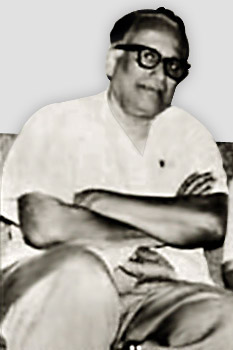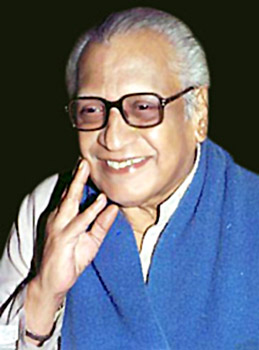 Marathi Poetry during Indian National Movement saw the emergence of a number of poets, and there was no single poet dominating the scene. C. S. Gorhe (1871-1937), `Chandrashekhar`, could be placed as a contemporary of Keshavsut, but his poetry belonged to an even earlier period. His poetry is a strange blend of the romantic and the classical. He was influenced by the works of Scott and Wordsworth. The technical skill in his longer poems likes "Kunjkunjana," "Kavitaratri," or "Godagaurava" are remindful of the pundit poets in Marathi literature.
Marathi Poetry during Indian National Movement saw the emergence of a number of poets, and there was no single poet dominating the scene. C. S. Gorhe (1871-1937), `Chandrashekhar`, could be placed as a contemporary of Keshavsut, but his poetry belonged to an even earlier period. His poetry is a strange blend of the romantic and the classical. He was influenced by the works of Scott and Wordsworth. The technical skill in his longer poems likes "Kunjkunjana," "Kavitaratri," or "Godagaurava" are remindful of the pundit poets in Marathi literature.
B. R. Tambe (1874-1941) had a much larger following. Poetry recitals had become a popular form of cultural event. During this time, the gramophone and radio started getting used widely and this further helped to popularize the musicality of his poems. The emphasis on sweet-sounding words, cadence, and lyricism was soothing to his predominantly Brahmin readers and audience in a disturbed world. His influence on Borkar, Padgaonkar, and Bapat can be seen in their early works.
Ravikiran Mandal, formed in 1923, was a group of young poets in Pune that dominated the scene for some time. These middle-class, educated poets tried to avoid the verbal and emotional extravagance of Gadakari and social activism of Keshavsut in poetry. The kind of poetry they preferred to write was romantic, mildly reformist, nostalgic to a certain extent and expressed certain escapist views on life. Yashwant D. Pendharkar, `Yashwant` and Shankar K. Kanetkar, `Girish` depicted in their poetry the picture of the simple life of rural Maharashtra. Madhav T. Patwardhan, `Madhav Julian`, preferred to write love poems in the form of ghazal (lyrics) with a liberal blend of Arabic, Persian, and Sanskrit language words. His collection of poems, Gajjalanjali, was published in 1933. Many critics thought that his love poems were too personal, but they also signify a shift toward a self-oriented view, to be seen in later poetry.
 The Ravikiran Mandal faded slowly, but its presence remained through parodies of its style. P. K. Atre (1898-1969) published his collection of parodies, Jhenduchi Phule, in 1925. Atmaram R. Deshpande (1901-82), `Anil`, began to write poetry as a conscious reaction against the mediocrity and unreality of Ravikiran Mandal. Anant Kanekar (1905-80) was another important poet who contributed to this process. His poetry represents an overlap between romanticism, a deep sense of social inequality and moral indignation.
The Ravikiran Mandal faded slowly, but its presence remained through parodies of its style. P. K. Atre (1898-1969) published his collection of parodies, Jhenduchi Phule, in 1925. Atmaram R. Deshpande (1901-82), `Anil`, began to write poetry as a conscious reaction against the mediocrity and unreality of Ravikiran Mandal. Anant Kanekar (1905-80) was another important poet who contributed to this process. His poetry represents an overlap between romanticism, a deep sense of social inequality and moral indignation.
His initial collection of poems, Phulwat (1932), is full of a sensitive, precise and subjective expression of love. His next two collections were Bhagnamurti (1940) and Nirvasita Chini Mulasa (1943). In Bhagnamurti, he employs Muktachhanda, or free verse, to contemplate the decline and fall of civilization. This reflection does not show despair but concentrates on causes of the decline. Here we see the return of passion for social change and a call for critical social consciousness. Nirvasita Chini Mulasa is a poem about an orphaned Chinese boy fleeing Japanese oppression. It clearly shows the poet`s ability to evoke powerful reactions such as compassion, indignation, and humanity. He was constantly experimenting with poetic forms and went on to develop a new form of sonnet known as the dashapadi, or a 10-line poem. He titled his collection by the same name in 1976, which received the Sahitya Akademi Award in 1977. His other collections include Perte Vha (1947) and Sangati (1961).
Anant Kanekar`s collection of poetry, Chandarata (1933), shows a deep awareness of the contradictions of an industrial society that was coming into existence. The moonlight is made to stand against smokestacks, the rejection of religion by the worker is paired with a wealthy owner`s conspicuous idol worship. The poems are full of satire, protest, atheism, and socialist visions. Later, he concentrated on essays and travelogues, but his social commitment remained deep.
Two other important poets of Anil`s generation are B. B. Borkar (1910-84) and Vishnu Vaman Shirwadkar (1912), Kusumagraja. Initially, Borkar`s poetry was influenced to a great extent by B.R. Tambe. However, he went beyond that and tried to incorporate the influences of poetry in several languages, the Portuguese culture of his native Goa, Bhakti poets, and Gandhian ideas. His important collections include Jeevan Sangeet (1937), Dudhasagar (1947), Anand Bhairavi (1950), Chitraveena (1960), and Chaitra Punav (1970). He remained a classical poet by following the traditional patterns of rhyme and rhythm. He also wrote some novels, with the same flair for language and narration. His Bhavin (1950) depicts a compassionate picture of the life of a devadasi (temple dancer).
Kusumagraj established himself as a major port during the Quit India Movement in 1942 with his first collection, Vishakha. His poems mirror the genuine nationalist spirit of the times. His other books, Jeevan Lahari and Kinare (1952), reflect his humanism and revolutionary zeal.
Thus discussed above is the state of poetry in Marathi literature during the Indian National Movement.













